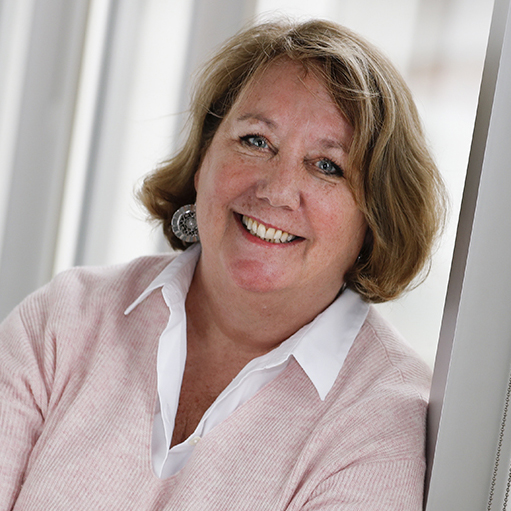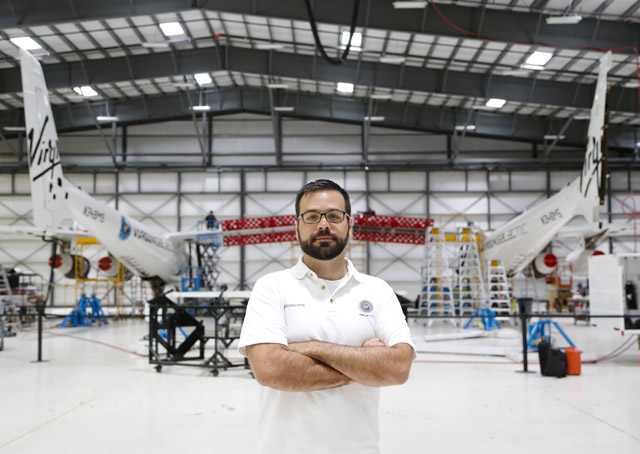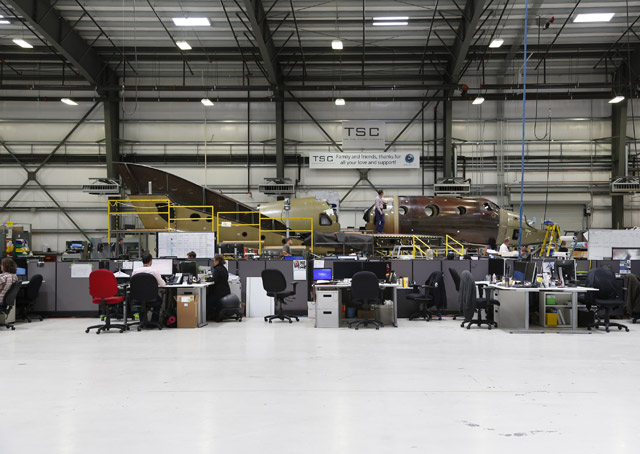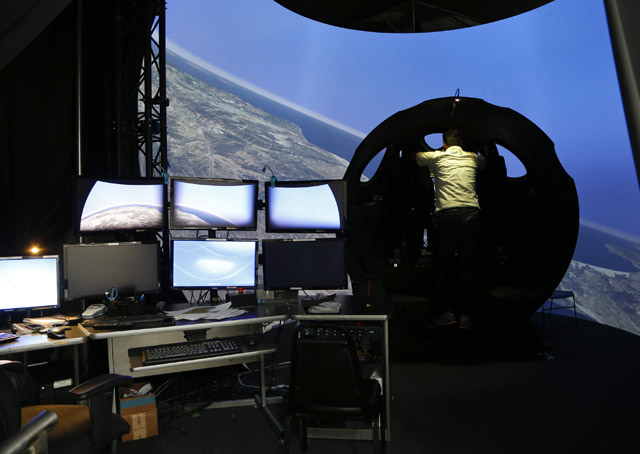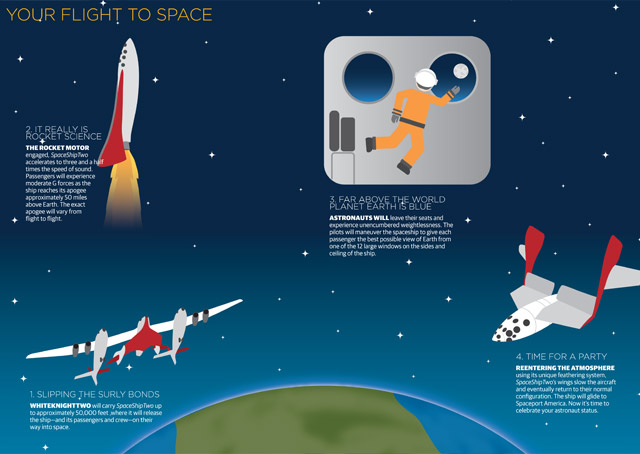 Checking the thermometer, it’s showing 99 degrees Fahrenheit. The road is so flat we are one with the earth in a low-body Ford Mustang. The landscape is barren, desolate. The “town” is a movie set from an spaghetti western—and yet we manage to drive past our destination. There are only several large, unadorned hangars here, so how can we miss the headquarters of one of the most remarkable aviation facilities in the world?
Checking the thermometer, it’s showing 99 degrees Fahrenheit. The road is so flat we are one with the earth in a low-body Ford Mustang. The landscape is barren, desolate. The “town” is a movie set from an spaghetti western—and yet we manage to drive past our destination. There are only several large, unadorned hangars here, so how can we miss the headquarters of one of the most remarkable aviation facilities in the world?
Virgin Galactic, The Spaceship Company, and Scaled Composites are all located in this hot stretch of windblown desert—Mojave, California. The heat hits you hard and the wind might sweep you off your feet. But behind the doors of Virgin Galactic, it’s air-conditioned cool and—at first—a little disappointing. There’s a reception area and modest couches. Three staffers are answering the phones. But in order to go further into the facility, we need to show passports and get credentialed, our badges gaining us entry into this think tank of the future. Oh, and Sir Richard Branson’s keeps an office right upstairs.
Branson is the visionary who realized that commercial human space flight wasn’t going to happen unless someone put money and energy toward it. So after Paul Allen and Burt Rutan won the $10 million Ansari XPrize in 2004 with SpaceShipOne, proving that a crewed spacecraft capable of carrying passengers could be successful, Branson copyrighted the name Virgin Galactic. “It was obvious that NASA wasn’t interested in getting you and me into space,” the British entrepreneur said. “Virgin Galactic sounded like a good name and after registering the name, I had to do something about it.”
We are greeted by Will Pomerantz, vice president of special projects for Virgin Galactic. We are late and will only have access to the facility for half an hour while the engineers and technicians working on SpaceShipTwo and WhiteKnight are on their lunch breaks. There will be no viewing of the beehive of activity in action—just the bare bones of the facility, its computer stations, and its warehousing. But we will stand right next to the massive fuselages of both the carrier and the spaceship—the two monster aircraft that promise the possibility of commercial human space flight. A spaceline for Earth.
“I work in a spaceship factory and I help make people astronauts,” says Pomerantz, who has enough energy and enthusiasm to propel him into space without a rocket booster. He’s obsessed about space travel. And he’s disappointed it’s taken this long to be a reality. “It’s 2015! Surely we would all be in space by now,” he exclaims.
Those of us who grew up watching The Jetsons, Michael J. Fox on a hovercraft, Harrison Ford in the Millennium Falcon, and, oh yes, Neil Armstrong taking that “small step” don’t believe it, either. Where are the flying cars, the moon rocks, the jetports, the robotic maids? We tasted astronaut ice cream, but that’s as close as we’ve come.
“Only 549 people have been in space,” Pomerantz laments. Five hundred or so people from the entire planet (world population as of July 2015: 7.349 billion). People like Pomerantz, who have been dreaming about space their entire lives, may be close to seeing the reality—as early as the end of this year. “Dates are hopes,” Pomerantz says.
Perhaps that first flight already would have happened if not for the tragedy on October 31, 2014. An in-flight breakup of SpaceShipTwo that killed co-pilot Michael Alsbury was ruled a “single human error” by the NTSB on July 28. It was a premature unlocking of the feather system—which allows the spaceship to slow for reentry—and the NTSB saw “no evidence of any structural system or rocket motor failures.”
There has been steady progress on the building of the new SpaceShipTwo. Undeterred by the accident, the crews of The Spaceship Company have been working three shifts a day, nights, and weekends, on the new aircraft. “We are working as quickly and safely as we can,” says Pomerantz. “We rolled up our sleeves and got right back to work.”
More than 700 tickets have been sold for the spaceline. You must fill out an application and the $250,000 fee for an hour and a half flight is paid up front. The flights are designed for six passengers—Branson and his family get to go first. Is $250K an astronomical number for a 90-minute flight? Would you have paid the Wright brothers $10,000 to fly with them (the equivalent in 2015 dollars)—or would you rather charter a yacht, buy a used Ferrari, or buy an Icon A5? You can fly to the International Space Station—the co-founder of Cirque du Soleil, Guy Laliberte, reportedly paid $35 million to spend 11 days on the Russian Soyuz spacecraft in 2009.
The current ticketholders are from more than 55 different countries and are of all ages, although you must be 18 to travel. Early purchasers paid $200,000 and the first 500 passengers who paid in full up-front will fly first. Some passengers have only placed 10-percent deposits. Well more than one dozen are females, Pomerantz says. Some are already in their 90s, still hoping to view Earth from the boundaries of space, 50 miles into the atmosphere. “Customers have literally dreamed of this for decades,” Pomerantz says. “Most customers say they want to see Earth from space.”
Passengers purchase tickets from “accredited space agents” and, once assigned their flight date, they will arrive in southern New Mexico, where the world’s first commercial spaceport—Spaceport America—is located. After three days of training—what Pomerantz calls “a three-day-long version of a flight attendant speech”—passengers will wake early on the morning of the fourth day, suit up (flight suits are being designed by professional fashion designers), and head out to the carrier.
A slow spiral up in the closed airspace above New Mexico takes about an hour, and then the spaceship is released from the carrier. It freefalls for about three seconds, and then the rocket shoots it up to space at Mach 3.5. The flight path is a steep vertical climb to the highest altitude—passengers will experience about 5 Gs on the ascent, which Pomerantz calls “the Right Stuff moment”—and then, in weightlessness, they will be free to move about the cabin. The seats will move away and passengers will float from window to window, viewing Earth for about five minutes.
Back into their seats, now reclined, passengers prepare for the reentry. Like a shuttlecock, the spaceship will reenter Earth’s atmosphere and, with the aid of the ship’s unique feathering system, slow and land back on Spaceport America’s 12,000-foot runway. “Now you’re an astronaut,” Pomerantz says. (NASA says if you’ve exceeded 50 miles above Earth, you’re an astronaut.) “And we’ll throw you a pretty good party, Virgin style.”
Someday, Pomerantz says, flights like this will take place daily and there will be a fleet of ships. And, if you’re saving money for your own flight, Pomerantz says he hopes it’ll cost less than $50,000 in fewer than 20 years. “Absolutely! If Virgin Galactic can’t be thinking 20 years down the road, who can?”
Email [email protected]
Video Extra: View the video.
